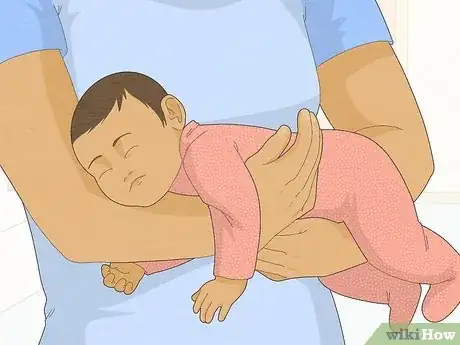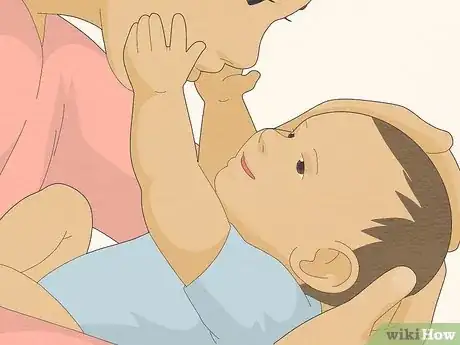This article was co-authored by Denise Stern and by wikiHow staff writer, Janice Tieperman. Denise Stern is a Parenting Specialist and the CEO of Let Mommy Sleep, the country’s leading Baby Nurse and Postpartum Care service. Denise specializes in providing nurturing care to newborns and evidence-based education to their parents. She holds a BA in Public Relations from North Carolina State University. Denise was the US Chamber of Commerce Leading Woman-Owned Business in 2013, a Washington FAMILY Magazine Mother of the Year in 2016, and on the elite White House Summit for Working Families hosted by the President and First Lady Obama in 2014. Let Mommy Sleep is the only company of its kind that holds a local government contract to teach newborn and postpartum care.
There are 15 references cited in this article, which can be found at the bottom of the page.
This article has been viewed 7,691 times.
What’s the best way to bond with your baby in the first few weeks and months? Cuddling, of course! This special, intimate, one-on-one time helps you emotionally connect with your child from the very beginning, and provides your babe with a ton of comfort and emotional support. Want to learn more? We’ve created a comprehensive guide that has everything you need to know about how to cuddle and spend plenty of quality time with your little one.
Steps
Expert Q&A
-
QuestionHow should you hold a baby?
 Denise SternDenise Stern is a Parenting Specialist and the CEO of Let Mommy Sleep, the country’s leading Baby Nurse and Postpartum Care service. Denise specializes in providing nurturing care to newborns and evidence-based education to their parents. She holds a BA in Public Relations from North Carolina State University. Denise was the US Chamber of Commerce Leading Woman-Owned Business in 2013, a Washington FAMILY Magazine Mother of the Year in 2016, and on the elite White House Summit for Working Families hosted by the President and First Lady Obama in 2014. Let Mommy Sleep is the only company of its kind that holds a local government contract to teach newborn and postpartum care.
Denise SternDenise Stern is a Parenting Specialist and the CEO of Let Mommy Sleep, the country’s leading Baby Nurse and Postpartum Care service. Denise specializes in providing nurturing care to newborns and evidence-based education to their parents. She holds a BA in Public Relations from North Carolina State University. Denise was the US Chamber of Commerce Leading Woman-Owned Business in 2013, a Washington FAMILY Magazine Mother of the Year in 2016, and on the elite White House Summit for Working Families hosted by the President and First Lady Obama in 2014. Let Mommy Sleep is the only company of its kind that holds a local government contract to teach newborn and postpartum care.
Parenting Specialist Babies' necks are not strong, and their heads are a bit heavy. So you should make sure to support the head and neck. Also, hold them firmly underneath their back.
Babies' necks are not strong, and their heads are a bit heavy. So you should make sure to support the head and neck. Also, hold them firmly underneath their back. -
QuestionWhy should you not make a newborn sleep on their stomach?
 Denise SternDenise Stern is a Parenting Specialist and the CEO of Let Mommy Sleep, the country’s leading Baby Nurse and Postpartum Care service. Denise specializes in providing nurturing care to newborns and evidence-based education to their parents. She holds a BA in Public Relations from North Carolina State University. Denise was the US Chamber of Commerce Leading Woman-Owned Business in 2013, a Washington FAMILY Magazine Mother of the Year in 2016, and on the elite White House Summit for Working Families hosted by the President and First Lady Obama in 2014. Let Mommy Sleep is the only company of its kind that holds a local government contract to teach newborn and postpartum care.
Denise SternDenise Stern is a Parenting Specialist and the CEO of Let Mommy Sleep, the country’s leading Baby Nurse and Postpartum Care service. Denise specializes in providing nurturing care to newborns and evidence-based education to their parents. She holds a BA in Public Relations from North Carolina State University. Denise was the US Chamber of Commerce Leading Woman-Owned Business in 2013, a Washington FAMILY Magazine Mother of the Year in 2016, and on the elite White House Summit for Working Families hosted by the President and First Lady Obama in 2014. Let Mommy Sleep is the only company of its kind that holds a local government contract to teach newborn and postpartum care.
Parenting Specialist A newborn should not be placed on their stomach for sleeping and napping because there is a risk of sudden infant death syndrome or sudden unexplained death syndrome.
A newborn should not be placed on their stomach for sleeping and napping because there is a risk of sudden infant death syndrome or sudden unexplained death syndrome.
References
- ↑ https://www.youtube.com/watch?v=DB1L0HkmKls&t=0m11s
- ↑ https://my.clevelandclinic.org/health/treatments/12578-kangaroo-care
- ↑ https://my.clevelandclinic.org/health/treatments/12578-kangaroo-care
- ↑ https://raisingchildren.net.au/newborns/health-daily-care/holding-newborns/how-to-hold-your-newborn
- ↑ https://www.pregnancybirthbaby.org.au/bonding-with-your-baby
- ↑ https://www.youtube.com/watch?v=DB1L0HkmKls&t=11s
- ↑ https://www.healthychildren.org/English/ages-stages/baby/crying-colic/Pages/Calming-A-Fussy-Baby.aspx
- ↑ https://azopt.net/hold-and-carry-your-baby/
- ↑ https://kidshealth.org/en/parents/tummy-time.html
- ↑ https://www.healthychildren.org/English/ages-stages/baby/crying-colic/Pages/Calming-A-Fussy-Baby.aspx
- ↑ https://myhealth.alberta.ca/Health/aftercareinformation/pages/conditions.aspx?hwid=abp9963
- ↑ https://www.scientificamerican.com/article/infant-touch/
- ↑ https://kidshealth.org/en/parents/bonding.html
- ↑ https://www.helpguide.org/articles/parenting-family/building-a-secure-attachment-bond-with-your-baby.htm
- ↑ https://kidshealth.org/en/parents/bonding.html
- ↑ https://www.helpguide.org/articles/parenting-family/building-a-secure-attachment-bond-with-your-baby.htm
- ↑ https://www.helpguide.org/articles/parenting-family/building-a-secure-attachment-bond-with-your-baby.htm
- ↑ https://www.bbc.com/future/article/20191001-the-word-gap-that-affects-how-your-babys-brain-grows
- ↑ https://www.helpguide.org/articles/parenting-family/building-a-secure-attachment-bond-with-your-baby.htm
- ↑ https://kidshealth.org/en/parents/learn13m.html
- ↑ https://caringforkids.cps.ca/handouts/pregnancy-and-babies/playtime_with_your_baby
- ↑ https://www.pregnancybirthbaby.org.au/bonding-with-your-baby








































































